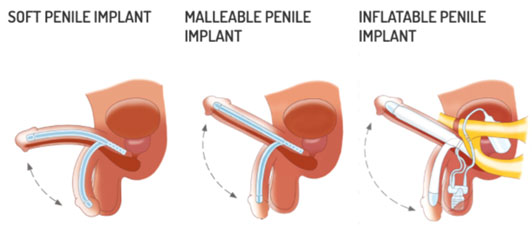
A penile implant, or penile prosthesis, is a treatment for erectile dysfunction (ED).
The surgery involves placing inflatable or flexible rods into the penis. Inflatable rods require a device filled with saline solution and a pump hidden in the scrotum. When you press on the pump, the saline solution travels to the device and inflates it, giving you an erection. Later, you can deflate the device again.
This procedure is usually reserved for men who have tried other ED treatments without success. Most men who have the surgery are satisfied with the results.
3-piece implant
Inflatable devices are the most commonly used type. A three-piece implant involves putting a fluid reservoir under the abdominal wall. The pump and release valve is implanted in the scrotum. Two inflatable cylinders are placed inside the penis.
It’s the most extensive type of penile implant surgery, but it creates the most rigid erection. There are more parts to potentially malfunction, however.
2-piece implant
There’s also a two-piece implant in which the reservoir is part of the pump that is placed in the scrotum. This surgery is a little less complicated. Erections are generally a bit less firm than with the three-piece implant. This pump may take more effort to work, but it requires less hand dexterity.
Semirigid implants
Another type of surgery uses semirigid rods, which aren’t inflatable. Once implanted, these devices stay firm all the time. You can position your penis against your body or bend it away from your body to have sex.
Another type of semirigid implant has a series of segments with a spring on each end. This makes it slightly easier to maintain positioning.
Surgery to implant semirigid rods is simpler than surgery for inflatable implants. They’re easier to use and less likely to malfunction. But semirigid rods put constant pressure on the penis and can be somewhat harder to conceal.
You may be a good candidate for penile implant surgery if you have:
The surgery may be performed using spinal anesthesia or general anesthesia.
Prior to surgery, the area is shaved. A catheter is placed to collect urine, and an intravenous line (IV) for antibiotics or other medications.
The surgeon makes an incision in your lower abdomen, the base of your penis, or just below the head of your penis.
Then the tissue in the penis, which is normally filled with blood during an erection, is stretched. The two inflatable cylinders are then placed inside your penis.
If you’ve chosen a two-piece inflatable device, the saline reservoir, valve, and pump are placed inside your scrotum. With a three-piece device, the pump goes in your scrotum, and the reservoir is inserted under the abdominal wall.
Finally, your surgeon closes the incisions. It’s usually done on an outpatient basis and the procedure generally takes 45 to 90 minutes but those times can vary.
Many inflatable penile implant surgeries are considered successful. (That is, they result in erections for intercourse.) Among men who have had the surgery, around 86% Trusted Source report satisfaction, according to a 2015 study.
Penile implants mimic a natural erection so you can have intercourse. They don’t help the head of the penis to get hard, nor do they affect sensation or orgasm.
As with any type of surgery, there’s a risk of infection, bleeding, and formation of scar tissue following the procedure. Rarely, complications like mechanical failures, erosion, or adhesion need surgery to repair or remove the implant.
If you have an established medical cause for ED, your insurer may cover the cost in whole or in part. Total costs depend on a variety of factors such as:
If you don’t have coverage, your doctor may agree to a self-pay plan. Request a cost estimate and contact your insurer before you schedule surgery. Most providers have an insurance specialist to help you navigate financial matters.
